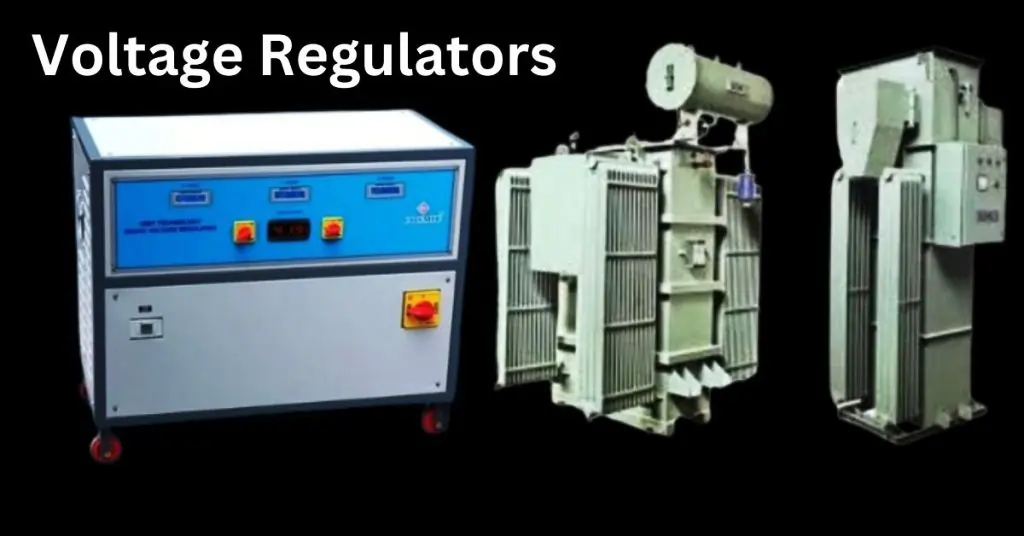Voltage Regulators
Did you know that optimizing voltage regulation can boost energy efficiency by up to 30%? In today’s world, where energy efficiency is paramount, voltage regulators play a crucial role in ensuring stable and reliable power supply across various applications. From industrial machinery to residential systems, these devices are indispensable for maintaining optimal voltage levels, thus enhancing performance and reducing energy waste.
In this blog post, we will explore seven ultimate advances in voltage regulator technology that are driving significant improvements in energy efficiency. These innovations range from smart IoT-integrated regulators to cutting-edge automotive applications, all designed to meet the growing demand for sustainable and efficient power solutions. Let’s dive into these groundbreaking developments and see how they are transforming the landscape of modern electrical systems.
Voltage Regulator in a Motor
A voltage regulator in a motor is a device or system designed to maintain a stable and constant voltage supply to the motor, regardless of variations in input voltage or load conditions. This ensures the motor operates efficiently and reliably, without experiencing performance issues due to fluctuating voltage levels.
Key Functions of a Voltage Regulator in Motors:
- Maintains Constant Voltage:
- The primary function of the voltage regulator is to ensure that the motor receives a consistent voltage. Voltage fluctuations can cause the motor to underperform or overheat, leading to damage or inefficiencies. The regulator compensates for any input voltage variations, providing a steady voltage to the motor.
- Prevents Motor Overheating:
- When the motor receives excessive voltage, it can overheat, causing insulation breakdown or even failure of the motor components. A voltage regulator limits the voltage supply, preventing overheating and protecting the motor from damage.
- Ensures Smooth Operation:
- Voltage regulators provide a smooth and stable power supply, ensuring that the motor runs without excessive speed fluctuations or power loss. This improves the overall performance and longevity of the motor.
- Compensates for Load Variations:
- In cases where the motor load varies, the voltage regulator helps maintain the correct voltage level, ensuring the motor can adapt to load changes without losing efficiency or speed. This is crucial in applications where motors drive varying loads, such as in conveyors, pumps, or elevators.
Types of Voltage Regulators Used in Motors:
- Automatic Voltage Regulators (AVR):
- AVRs are commonly used in larger AC motors and generators. They automatically adjust the voltage by controlling the excitation of the motor’s windings, ensuring that output voltage remains constant despite input fluctuations.
- Linear Voltage Regulators:
- These regulators provide a constant voltage output by dropping excess voltage as heat. They are used in low-power applications where precise voltage control is needed.
- Switching Voltage Regulators:
- More efficient than linear regulators, switching regulators use electronic switches (like transistors) to convert and stabilize voltage. These are often used in DC motors to ensure a stable voltage supply with minimal energy loss.
- Brushless DC Motor Controllers:
- In brushless DC motors (BLDC), voltage regulation is achieved through electronic controllers that regulate the voltage applied to the motor’s windings, ensuring smooth operation at varying speeds and loads.
Applications of Voltage Regulators in Motors:
- Industrial Motors: Voltage regulators are critical in industrial applications where motors operate under varying loads and conditions, ensuring smooth performance and preventing damage.
- Generators: Motors coupled with generators use voltage regulators to stabilize the voltage output, ensuring reliable power supply for industrial equipment or electrical grids.
- Appliances: In household appliances like fans, refrigerators, and washing machines, voltage regulators ensure that motors operate efficiently without the risk of damage due to voltage fluctuations.
- Marine and Automotive Motors: In marine and automotive systems, voltage regulators protect motor-driven systems from unstable voltage caused by alternator or generator issues.
Enhanced Energy Efficiency
Overview
Voltage regulators play a pivotal role in boosting energy efficiency by maintaining consistent voltage levels across electrical systems. They ensure that the supplied voltage is within the optimal range, minimizing energy losses and enhancing the performance of connected devices. By stabilizing voltage fluctuations, voltage regulators prevent overconsumption of energy, reduce waste, and improve the overall efficiency of power distribution systems. This is crucial in both industrial and residential settings where energy efficiency translates directly into cost savings and reduced environmental impact.
Technologies
Smart Voltage Regulators: Incorporating IoT connectivity and real-time monitoring, smart voltage regulators can dynamically adjust voltage levels based on current demand and conditions, ensuring optimal energy use.
Switching Voltage Regulators (SMPS): These regulators operate by switching on and off rapidly, using inductors, capacitors, and transformers to regulate voltage efficiently. They are highly efficient, often exceeding 90%, which makes them ideal for applications where energy conservation is critical.
Advanced Control Algorithms: Modern voltage regulators employ sophisticated control algorithms to predict and respond to changes in load and supply conditions. These algorithms optimize the voltage regulation process, reducing energy waste.
Renewable Energy Integration: Voltage regulators used in renewable energy systems, such as solar and wind power, ensure that the variable output from these sources is stabilized and efficiently converted for use, maximizing energy capture and utilization.
Energy Harvesting Technologies: Some advanced voltage regulators incorporate energy harvesting capabilities, capturing and utilizing waste energy from the system to further improve overall efficiency.
Case Studies
Industrial Manufacturing Plant
- Situation: An industrial manufacturing plant was experiencing high energy costs due to inefficient voltage regulation.
- Solution: The plant installed smart voltage regulators with IoT integration and real-time monitoring.
- Result: The regulators optimized voltage levels across the facility, leading to a 15% reduction in energy consumption and significant cost savings.
Data Center
- Situation: A large data center faced challenges in maintaining stable voltage levels, resulting in energy inefficiencies and potential risks to sensitive equipment.
- Solution: Switching voltage regulators with advanced control algorithms were implemented.
- Result: The data center achieved over 20% improvement in energy efficiency, reduced cooling requirements, and enhanced equipment reliability.
Residential Solar Power System
- Situation: A residential area with solar power systems struggled with inconsistent voltage output from the solar panels.
- Solution: Renewable energy integration voltage regulators were installed to stabilize the voltage output.
- Result: Homeowners experienced a 25% increase in energy efficiency, maximizing the use of solar energy and reducing dependency on the grid.
Automotive Sector
- Situation: An electric vehicle manufacturer needed to enhance the energy efficiency of their vehicles to extend battery life and improve performance.
- Solution: Programmable voltage regulators with energy harvesting technology were integrated into the vehicles.
- Result: The vehicles demonstrated a 10% increase in overall energy efficiency, extending the driving range and reducing charging frequency.
Difference Between High Voltage and Low Voltage (Apart from Voltage Rating)
Apart from the obvious distinction in voltage rating, high voltage and low voltage systems differ in several other important aspects, including safety, insulation requirements, power transmission efficiency, and applications. Here are key differences:
1. Safety Considerations
- High Voltage: High voltage systems pose a greater safety risk due to the potential for severe electrical shocks and arcing. Special safety protocols, insulation, and equipment are required to handle high voltage safely. Personnel working with high voltage must follow strict safety guidelines, including the use of protective equipment.
- Low Voltage: Low voltage systems are generally safer to work with, and the risk of electrical shock is much lower. While still requiring proper precautions, the risk of injury or equipment damage is significantly reduced compared to high voltage systems.
2. Insulation Requirements
- High Voltage: Insulation requirements are much more stringent for high voltage systems due to the increased potential for arcing and insulation breakdown. Special insulating materials and designs are needed to prevent leakage currents, short circuits, or equipment failures.
- Low Voltage: Low voltage systems require less insulation, and the insulating materials used are typically lighter and less expensive. The potential for electrical breakdown in insulation is much lower in low voltage applications.
3. Power Transmission Efficiency
- High Voltage: High voltage systems are more efficient for transmitting power over long distances. The higher the voltage, the lower the current required to transmit the same amount of power, which reduces energy losses due to resistance in the transmission lines.
- Low Voltage: Low voltage systems are less efficient for long-distance power transmission because higher currents are required to transmit the same power, leading to greater energy losses through resistance. Low voltage is generally used for short-distance transmission or distribution.
4. Application and Usage
- High Voltage: High voltage systems are used in large-scale industrial applications, power transmission over long distances, and equipment that requires substantial electrical power, such as transformers, generators, and motors in power plants.
- Low Voltage: Low voltage systems are used in residential, commercial, and small-scale industrial settings. Typical applications include lighting, household appliances, low-power machinery, and electronics.
5. Equipment Size and Complexity
- High Voltage: Equipment designed for high voltage, such as transformers, circuit breakers, and switchgear, tends to be larger, heavier, and more complex due to the need for robust insulation, cooling, and protection systems.
- Low Voltage: Low voltage equipment is smaller, simpler, and easier to handle. Low voltage systems do not require the same level of complexity in terms of insulation and cooling, making them more compact and easier to install.
6. Switching and Protection Devices
- High Voltage: High voltage systems require more sophisticated and durable switching and protection devices to handle large voltages safely. Circuit breakers, fuses, and relays for high voltage systems are designed to interrupt large currents and prevent arcing.
- Low Voltage: In low voltage systems, switching devices and protection equipment are simpler and more cost-effective. The devices do not need to handle as much energy, and there is less risk of arcing.
7. Maintenance Requirements
- High Voltage: High voltage systems require more frequent and specialized maintenance due to the higher risk of insulation degradation, electrical faults, and wear on components. Regular inspections, testing, and specialized personnel are needed to maintain high voltage equipment.
- Low Voltage: Low voltage systems are easier to maintain and require less frequent and complex servicing. The risks of component degradation are lower, making maintenance simpler and less expensive.
How Much is the Operating Voltage Onboard a Ship?
The operating voltage onboard a ship is typically 440 volts, 3-phase, and 60 Hz, which is the standard for most commercial vessels. This voltage level is sufficient to power various onboard machinery, including pumps, motors, compressors, and auxiliary systems. However, the voltage requirements can vary depending on the size of the ship and the type of equipment it operates.
Factors Affecting Voltage Requirements:
- Ship Size: As ships increase in size, their electrical demands also rise. Larger ships often have more extensive power distribution systems to support powerful engines, propulsion systems, and additional equipment, requiring higher electrical capacities.
- Machinery and Equipment: Modern vessels are equipped with advanced and energy-intensive machinery, such as high-powered engines, generators, and navigation systems. The electrical load is directly proportional to the amount and size of this equipment, sometimes necessitating higher operating voltages.
Higher Voltage for Larger Ships:
On larger vessels, the operating voltage may exceed 440V to accommodate the increased power demand. Some ships may utilize 6.6kV or even 11kV systems for specific high-power applications, such as propulsion and large-scale auxiliary equipment. This allows efficient power transmission over longer distances within the ship without significant losses.
In summary, while 440V, 3-phase, 60 Hz is the standard operating voltage on most ships, larger vessels with more machinery may require higher voltage systems to meet their extensive electrical power needs.
Important Formulas
Ohm’s Law
Ohm’s Law is a fundamental principle used to calculate the relationship between voltage, current, and resistance in an electrical circuit. It is essential for designing and analyzing electrical systems.

Power Formula
The Power Formula calculates the power consumed or produced by an electrical component based on the voltage and current. It is crucial for determining the energy requirements and efficiency of electrical systems.
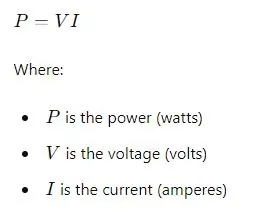
Efficiency Calculation
Efficiency is a measure of how effectively a device converts input power into useful output power. Higher efficiency indicates less energy loss during the conversion process.
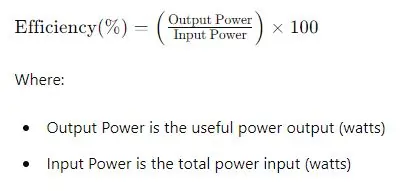
Regulation Formula
Voltage Regulation measures the change in output voltage of a regulator as the load varies from no-load to full-load. It indicates the regulator’s ability to maintain a constant output voltage.
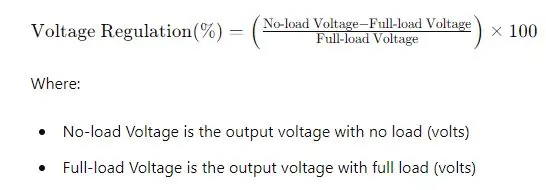
Load Regulation
Load Regulation quantifies the variation in output voltage as the load current changes, highlighting the stability and performance of the voltage regulator under different load conditions.
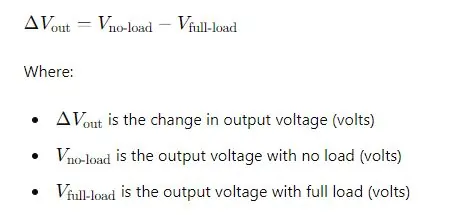
Renewable Energy Systems Integration
Explanation
Voltage regulators are essential components in renewable energy systems, such as solar and wind power installations, where they play a critical role in managing and stabilizing the variable output generated by these sources. In renewable energy systems, the power output can fluctuate significantly due to changing environmental conditions—like cloud cover for solar panels or wind speed variations for wind turbines. Voltage regulators ensure that these fluctuations are smoothed out, providing a consistent and stable voltage supply to the grid or directly to end-users. This is crucial for integrating renewable energy into the existing power infrastructure and for the effective operation of off-grid renewable systems.
Stability
Maintaining consistent voltage levels is vital for the efficient functioning of electrical systems and the protection of connected equipment. In renewable energy systems, voltage regulators:
- Prevent Voltage Spikes and Drops: By stabilizing the output voltage, regulators protect sensitive electronics and electrical devices from damage caused by sudden voltage changes.
- Enhance Power Quality: Consistent voltage levels ensure high power quality, reducing the risk of interruptions, flickering, and other issues that can affect both industrial processes and residential comfort.
- Optimize Energy Conversion: Voltage regulators help maximize the efficiency of energy conversion from DC (direct current) generated by solar panels or wind turbines to AC (alternating current) used by most electrical devices and the power grid.
Impact
The integration of voltage regulators into renewable energy systems has a profound positive impact on both system reliability and overall energy output:
System Reliability:
- Enhanced Equipment Lifespan: By providing stable voltage levels, voltage regulators reduce the wear and tear on electrical components, thereby extending their operational lifespan.
- Reduced Downtime: Stable voltage minimizes the risk of system failures and downtime, ensuring continuous operation and reliability of power supply.
- Improved Safety: Consistent voltage levels prevent overheating and other issues that could lead to hazardous situations, enhancing the overall safety of the system.
Overall Energy Output:
- Maximized Energy Harvesting: Voltage regulators ensure that the maximum possible energy is harvested from renewable sources by optimizing the voltage levels at which energy is stored or fed into the grid.
- Increased Efficiency: By maintaining optimal voltage levels, regulators reduce energy losses during conversion and distribution, leading to higher overall system efficiency.
- Grid Stability: In grid-connected renewable systems, voltage regulators help maintain grid stability by ensuring that the power fed into the grid is at the correct voltage level, preventing disruptions and maintaining a balanced supply-demand scenario.
Case Study: Solar Power Plant Integration
- Situation: A large-scale solar power plant experienced significant voltage fluctuations due to variable sunlight conditions.
- Solution: High-efficiency voltage regulators were installed to manage the output from the solar panels.
- Result: The plant saw a 20% improvement in energy output efficiency, with a stable and reliable supply of electricity fed into the grid, reducing dependency on fossil fuels.
Case Study: Wind Farm Stability
- Situation: A wind farm faced challenges with inconsistent power output due to varying wind speeds.
- Solution: Advanced switching voltage regulators were integrated into the system to stabilize the voltage levels.
- Result: The wind farm achieved a 15% increase in system reliability and a smoother integration with the national grid, providing a steady and reliable source of renewable energy.
Marine Innovations
Relevance
The importance of voltage regulators in marine applications is growing rapidly as vessels become more technologically advanced and reliant on sophisticated electrical systems. From luxury yachts to commercial ships, maintaining a stable and consistent voltage supply is crucial for the optimal performance of navigation systems, communication equipment, propulsion systems, and onboard amenities. In marine environments, where power sources can be variable and unpredictable, voltage regulators ensure the reliability and efficiency of electrical systems, enhancing safety and operational performance.
Performance
Innovations in voltage regulation technology have significantly improved the performance and reliability of marine vessels in several ways:
- High-Efficiency Switching Regulators: Modern marine vessels use high-efficiency switching voltage regulators to handle varying load conditions and minimize energy losses. This is particularly important for optimizing the performance of propulsion systems and reducing fuel consumption.
- Advanced Power Management Systems (PMS): Voltage regulators are integral to advanced PMS that monitor and manage the distribution of power throughout the vessel. These systems ensure that critical systems receive stable voltage, enhancing reliability and safety.
- Dynamic Voltage Scaling (DVS): This technology allows voltage regulators to adjust the power supply dynamically based on real-time demands, optimizing energy consumption for different operational states. DVS contributes to improved fuel efficiency and reduced emissions in marine vessels.
- Thermal Management: Voltage regulators equipped with advanced thermal management capabilities prevent overheating, ensuring that electronic components within the vessel operate within safe temperature ranges. This protection is crucial for maintaining long-term reliability and performance in harsh marine environments.
- Integration with Renewable Energy Systems: Voltage regulators help manage the energy captured from renewable sources like solar panels and wind turbines, ensuring efficient storage and usage. This integration improves the overall energy efficiency and sustainability of marine vessels.
Future Trends
As the marine industry continues to evolve, several future trends and developments are expected to further enhance the role of voltage regulators in marine applications:
- Increased Adoption of Hybrid and Electric Propulsion: The development and integration of hybrid and electric propulsion systems in marine vessels will require advanced voltage regulation technologies to manage the unique charging and discharging characteristics of batteries and power systems.
- Wireless Power Transfer: The proliferation of wireless power transfer systems for marine applications will necessitate sophisticated voltage regulators to ensure efficient energy transfer and stable voltage supply during the charging process.
- AI and Machine Learning Integration: The use of AI and machine learning algorithms in voltage regulation systems will enable predictive maintenance and optimization of power management, further enhancing vessel performance and efficiency.
- Enhanced Connectivity: Future voltage regulators will likely be part of more integrated and connected systems, enabling real-time communication with other vessel components and external infrastructure to optimize energy use and performance.
- Lightweight and Compact Designs: Ongoing advancements in materials science and electronic engineering will lead to the development of more lightweight and compact voltage regulators, contributing to overall vessel weight reduction and improved energy efficiency.
Miniaturization and Integration
| Aspect | Description |
|---|---|
| Trend | The trend towards miniaturization and integration in voltage regulators is driven by the demand for smaller, more efficient electronic devices. Modern voltage regulators are designed to be compact and highly integrated, incorporating multiple functions into a single chip. This trend is evident in consumer electronics, automotive systems, and industrial applications where space and efficiency are critical. By reducing the size and integrating additional features, manufacturers can offer more powerful and versatile solutions that meet the growing needs of various industries. |
| Applications | Consumer Electronics: Smartphones, tablets, and wearable devices benefit from miniaturized voltage regulators to save space and improve battery life. Automotive Systems: In-vehicle infotainment systems, advanced driver-assistance systems (ADAS), and electric vehicle power management systems utilize compact regulators to optimize performance and reduce weight. Medical Devices: Portable and implantable medical devices require small, efficient regulators to ensure reliable operation without adding bulk. Industrial Equipment: Automation systems, sensors, and control units in industrial settings benefit from miniaturized regulators to enhance functionality while minimizing space requirements. Aerospace and Defense: Avionics and defense electronics use compact voltage regulators to meet stringent size, weight, and power (SWaP) requirements. |
| Advantages | Space-Saving: Miniaturized voltage regulators occupy less space, allowing for more compact and lightweight designs. This is crucial in applications where space is at a premium, such as in portable electronics and automotive systems. Efficiency: Smaller, integrated voltage regulators often have improved efficiency, reducing power losses and enhancing overall system performance. This leads to longer battery life in portable devices and lower energy consumption in larger systems. Enhanced Functionality: Integration of additional features into a single chip reduces the need for multiple discrete components, simplifying design and increasing reliability. This also allows for more sophisticated power management solutions that can adapt to varying operational conditions. Cost-Effective: Reducing the number of components and simplifying assembly processes can lead to lower manufacturing costs. This makes miniaturized voltage regulators an attractive option for high-volume applications. |
FAQ on “Voltage Regulators”
Q: What is the primary function of a voltage regulator?
A: To maintain a consistent output voltage.
Q: How do switching voltage regulators differ from linear voltage regulators?
A: Switching regulators are more efficient than linear ones.
Q: Why are voltage regulators important in renewable energy systems?
A: They stabilize variable output from renewable sources.
Q: Can voltage regulators improve the energy efficiency of electronic devices?
A: Yes, they reduce energy waste and enhance efficiency.
Conclusion
Voltage regulators are essential components in modern electrical and electronic systems, ensuring consistent and reliable voltage levels across a wide range of applications. From enhancing energy efficiency and integrating renewable energy systems to driving innovations in automotive and marine sectors, voltage regulators play a pivotal role in optimizing performance and reducing energy waste. By understanding the different types and latest advancements in voltage regulation technology, engineers and technicians can better design and maintain efficient, reliable, and sustainable power systems. As technology continues to evolve, the importance of voltage regulators will only grow, making them a cornerstone of modern electrical engineering.
